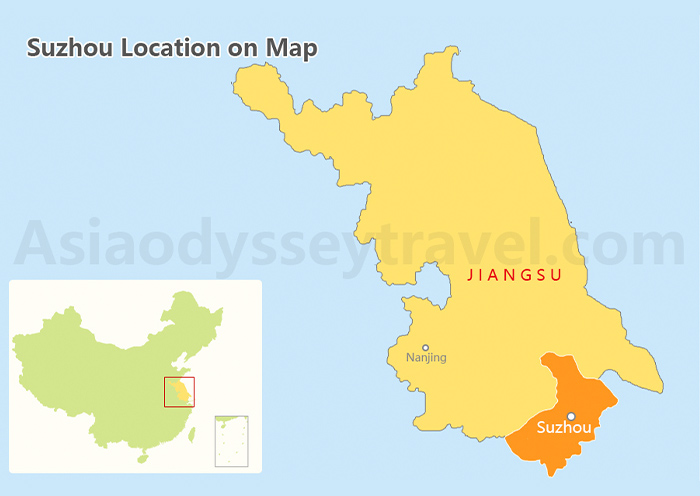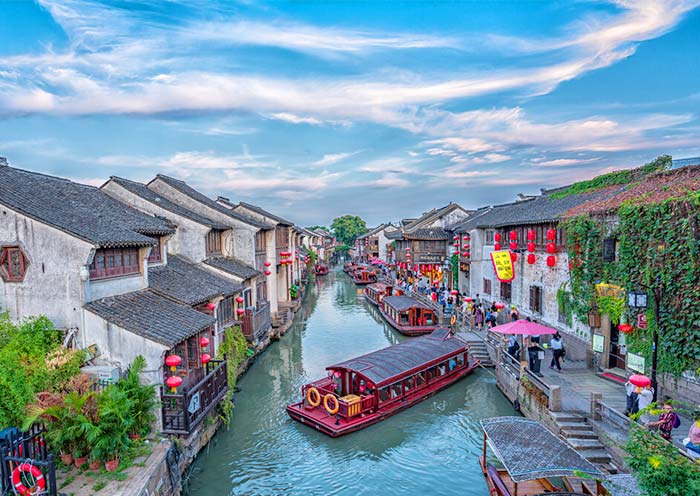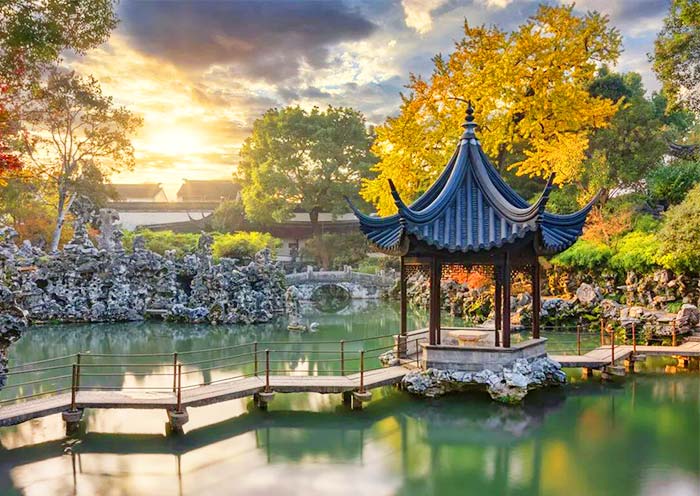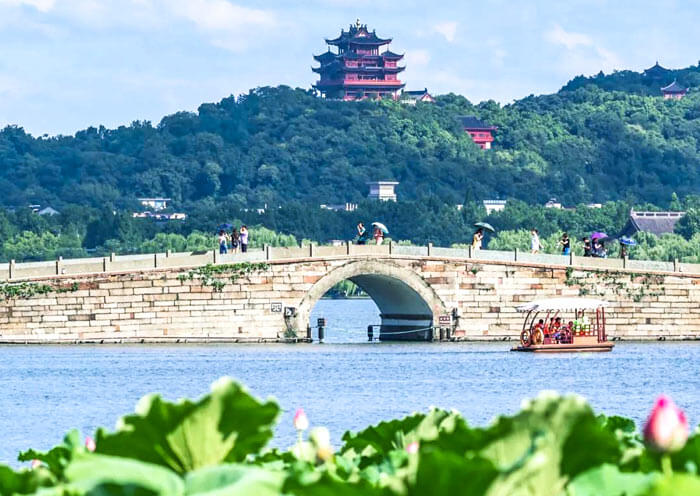No.1 Humble Administrators Garden - The Epitome of China's Classical Gardens
Location: No.178 Dongbei Street, Gusu District, Suzhou City (苏州市姑苏区东北街178号), close to Lion Grove Garden
History & When to Built: Over 500 Years
Featured Highlights: the largest classical gardens in China, one of the four famous gardens of China
The Humble Administrator's Garden (拙政园), first constructed in the early years of the Ming Dynasty's Zhengde era (early 16th century), is a representative masterpiece of classical gardens in the Jiangnan region of China. Alongside Beijing's Summer Palace, Chengde's Mountain Resort, and Suzhou's Lingering Garden, it is renowned as one of the four famous gardens of China. In 1997, it was inscribed on the UNESCO World Heritage List.
With the artistic contributions of the revered literatus Wen Zhengming (1470-1559) - a renowned Chinese painter, calligrapher, and Ming Dynasty scholar - the Humble Administrator's Garden exudes a captivating literary atmosphere, unveiling poetic and picturesque scenes throughout its enchanting landscape. This extraordinary garden harmoniously blends natural elements such as serene ponds, idyllic islands, elegant bridges, graceful pavilions, and captivating rock formations, creating a tapestry that epitomizes serenity and beauty.


Humble Administrators Garden Layout
The garden's allure lies in its meticulous layout, elevating it beyond ordinary gardens. Its seamless integration of nature and art forms a profound connection between humans and their environment. Strolling through its enchanting pathways, visitors are immersed in a living landscape painting, where each step unveils a new vista of captivating beauty.
Divided into three sections, the Humble Administrator's Garden offers distinct allure and character. The eastern part, formerly known as the "Returning to the Countryside Residence," immerses visitors in a pastoral oasis of sublime tranquility. The central part, aptly named the "Reconstructed Garden," reveals the garden's essence through captivating ponds, picturesque islands, and meticulously crafted artificial hills. The western part, the "Supplementary Garden," showcases architectural marvels from the Qing Dynasty, boasting a unique style that differentiates it from the eastern and central sections, adding a touch of architectural splendor to the overall composition.
How to Visit Humble Administrators Garden, Suzhou?
You will visit from the Entrance → Suzhou Garden Museum → the eastern part → the central part → the western part → Exit. As travelers stroll along the corridors, the scenery constantly transforms with the changing patterns of the latticed windows, creating a phenomenon known as "changing scenery with every step".
No.2 Lingering Garden - Small but Exquisite Classical Garden
Location: No.338 Liuyuan Road, Gusu District, Suzhou City (苏州市姑苏区阊门外留园路338号)
History & When to Built: Over 400 Years
Featured Highlights: Striking architecture, remarkable rock structures, Cultural Events and Performances
The Lingering Garden (留园), a magnificent classical private garden in China, beautifully showcases the architectural style of the Qing Dynasty. Its grand and splendid halls, along with its ever-changing courtyards, are a testament to the garden's artistic prowess. With its irregular layout, the garden seamlessly blends its architectural elements with the surrounding mountains, water, and rocks, creating a serene and harmonious ambiance.
Recognized for its significance, the Lingering Garden was inscribed in the World Heritage List in 1997 as a representative example of classical gardens in Suzhou. Furthermore, in 2007, the Suzhou Gardens, which include the Humble Administrator's Garden, Tiger Hill, and the Lingering Garden, were honored with a prestigious National 5A-level tourist attraction rating.
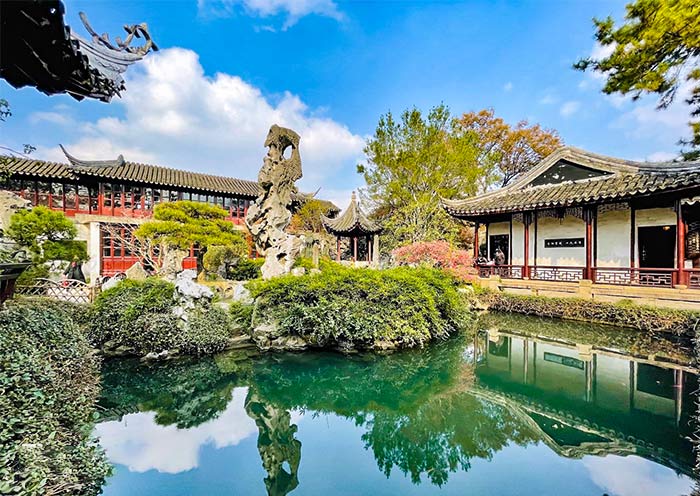
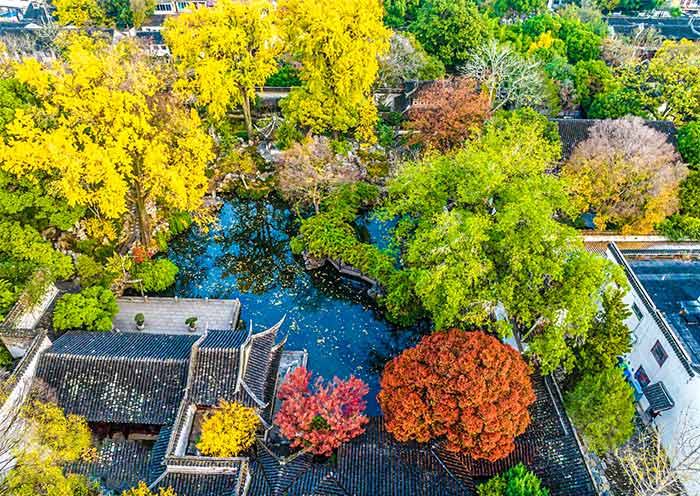
Three Wonders of the Lingering Garden
Crown Cloud Peak (冠云峰)
Crown Cloud Peak is the tallest lake stone peak in China. It dates back to the Song Dynasty's "Hua Shi Gang" and stands at 6.5 meters tall. With its grayish-white color and arched shape, it resembles a grand crown. The peak's remarkable qualities of emptiness, transparency, slimness, and erectness make it a top-quality stone.
Nanmu Hall (楠木殿)
Nanmu Hall, also known as the "Hall of Five Peaks Immortals" is a beautifully decorated hall in the garden. It is renowned as the finest hall in Jiangnan and gets its name from the abundant use of nanmu wood in its beams, columns, and furniture.
Fish Fossils (鱼化石)
Within a glass frame in Guan Yunlou, there are fish fossils measuring 4.6 meters in length and 1.25 meters in width. These fossils preserve over 20 fish species, each over ten centimeters long. Dating back over 140 million years, these rare and precious fossils hold great aesthetic value.
How to Visit Lingering Garden, Suzhou?
The Lingering Garden may not be large in size, but its layout is remarkably clear. The central area features a landscape, the eastern section consists of courtyards, the western part showcases mountain peaks, and the northern area houses a bonsai garden. The essence of the garden is concentrated in the central and eastern sections.
Recommended Visiting Route:
Entrance → The Eastern Part ( Qu Xi Lou, Hall of Five Peaks Immortals, Crown Cloud Peak, Linquan Qishuo Zhi Guan (林泉耆硕之馆)) → The Central Part (Hanbi Shanfang (涵碧山房), Mingse Tower) → The Western Part (Wen Muxixiang Xuan (闻木樨香轩), Zhi Le Pavilion, Shuxiao Pavilion) → Exit.
No.3 Master of the Nets Garden - The Smallest Garden with Elegant Design & the Most Delicate Charm
Location: No.11 Kuojiatou Alley, Gusu District, Suzhou City (苏州市姑苏区阔家头巷11号)
History & When to Built: Over 800 Years
Featured Highlights: Water & pond is the main theme; Intricate Rockeries; exquisite and diminutive charm; evening visiting with performance
The Master of the Nets Garden (网师园), one of the four renowned gardens of the late Qing Dynasty, is a prime example of a typical Suzhou-style residential garden. Its origins date back to the Southern Song Dynasty when it was initially named "Yuyin". During the early Qing Dynasty, it was given the name "The Master of the Nets Garden".
This garden is celebrated for its small yet elegant design, faithfully preserving the architectural style of old Suzhou mansions and seamlessly integrating the residence with the surrounding garden. At its heart lies a central pond, encircled by pavilions, corridors, rock formations, and lush vegetation, creating a tranquil and harmonious main landscape. Despite its abundance of structures, the garden's meticulous planning allows for a sense of spaciousness, achieved through the incorporation of various elements and smaller gardens within its confines.
Regarded as the pinnacle of small-scale gardens in Suzhou, the Master of the Nets Garden exemplifies the Chinese design philosophy of "less is more". Spanning a mere eight acres, occupying less than one-sixth of the Humble Administrator's Garden, it showcases a compact layout centered around the theme of water. The arrangement along the pond is characterized by its simplicity and naturalness, renowned for its exquisite and diminutive charm.
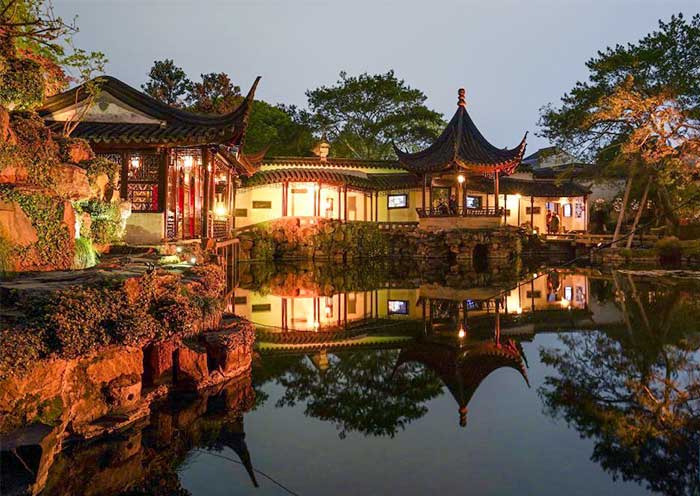
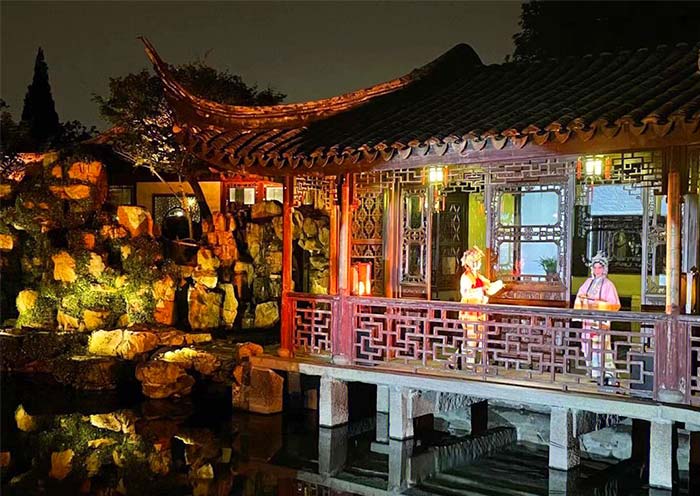
The Master of the Nets Garden Layout & How to Visit
The Master of the Nets Garden can be roughly divided into three sections: east, middle, and west. (1) The eastern section consists of three entrances and four halls, forming a well-organized residential courtyard. The main attraction is the remarkable brick-carved gatehouse known as the "Number One Gateway in Jiangnan". (2) The middle section revolves around a central water pond. Despite its small size of only half an acre, the skillful arrangement of flowers, plants, rocks, and buildings along the pond creates a sense of spaciousness. With only a few water lilies adorning the water surface, the pond gives an impression of expansiveness and serves as the highlight of the entire garden. (3) The western section is home to a renowned garden within the garden known as the "Dian Chun Yi Courtyard." The Chinese-style courtyard called "Ming Xuan" in the Metropolitan Museum of Art in New York City was constructed based on the design of the Dian Chun Yi Courtyard.
Explore the Master of the Nets Garden at Night
In the evening, you can immerse yourself in a vivid performance featuring the distinctive culture of Suzhou gardens. The performances include Kunqu opera, storytelling, Jiangnan silk and bamboo music, guqin, zither dance, flute, and more.
No.4 Lion Grove Garden - Dominated by Elaborate Rock Formations
Location: No.23 Yuanlin Road, Gusu District, Suzhou City (苏州市姑苏区园林路23号 邮政编码: 215005), close to Humble Administrator's Garden
History & When to Built: Over 600 Years
Featured Highlights: Lion-Shaped Rock Formations, Exquisite Lake Tai Stones; Fusion of Buddhist and Traditional Garden Design; Pei Family Legacy
The Lion Grove Garden has over 660 years of history, originally constructed in 1351 during the Yuan Dynasty (1271 - 1368). As one of the four famous gardens in Suzhou, it is renowned as the "Kingdom of Rockery" for its abundant lion-shaped rock formations. Emperor Qianlong (reigned in 1736-1796) visited the garden six times during his trips to southern China, reflecting its prestige. The garden is also the ancestral home of famed architect I.M. Pei (贝聿铭大师).
The Lion Grove Garden is named for its lion-shaped rocks and lakeside stones, which are intricately designed. Key architectural structures include the Yanyu Hall, Jian Shan Tower, Fei Pu Pavilion and Wen Mei Pavilion. Over time, the garden has evolved through temple and residence mergers, integrating Buddhist principles with garden aesthetics. The Pei family added ancestral halls and Western elements, creating a harmonious blend.
The garden architecture has three parts - ancestral halls, residences, and gardens. The current entrance was originally the Pei ancestral hall, with two grand halls. In summary, the Lion Grove Garden has a long history, unique rockery, famous ownership, and diverse architectural blending, cementing its status as one of Suzhou's top gardens.
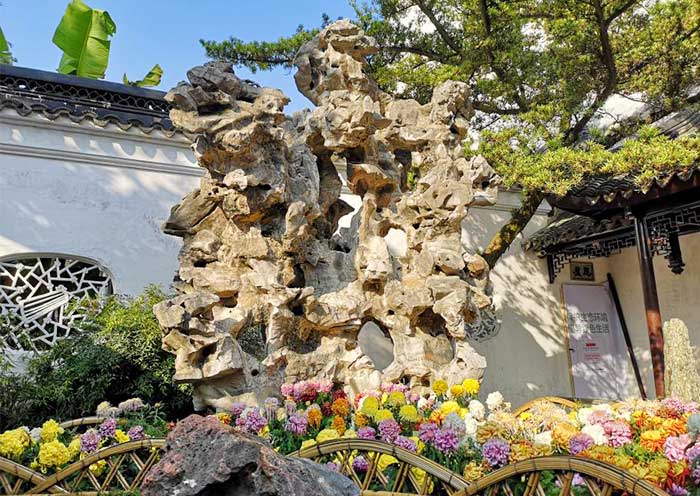
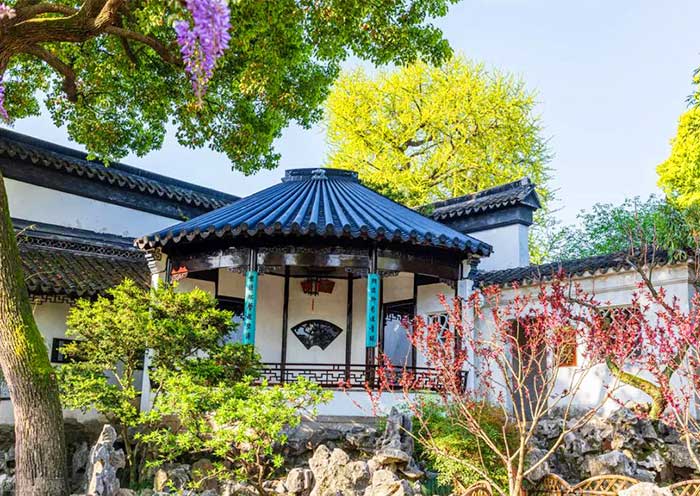
No.5 Canglang Pavilion - The Oldest Garden in Suzhou with 1000 Years’ History
Location: No.3 Canglangting Street, Canglang District, Suzhou City (苏州市沧浪区沧浪亭街3号), close to Ke Garden
History & When to Built: About 1000 Years
Featured Highlights:
Canglang Pavilion (沧浪亭), considered one of the four famous gardens of Suzhou, is the oldest existing garden in the city. It was first built during the Northern Song dynasty in the Qingli reign (1041-1048 AD). The Northern Song poet Su Shunqin retired to Canglang Pavilion after being demoted, and named the garden after it. In the early Southern Song dynasty (early 12th century), it became the residence of the famous general Han Shizhong (韩世忠). It is a part of the classical Suzhou gardens declared a UNESCO World Heritage Site in 1997.
The layout of Canglang Pavilion features scenic pools and rockeries. Before entering the front garden gate, there is a pool of green water winding around the outside. Inside, rockeries are the main feature. An artificial hill stands in front, atop which sits Canglang Pavilion. This small mountain creates undulating hills and valleys, dispersing focal points throughout the garden. At the foot of the hill lies a pool, connected to the mountain scene by a winding covered corridor. To the southeast of the rockery is Mingdao Hall, the main building, as well as other structures like the Hall of Five Hundred Worthies.
Canglang Pavilion's latticed windows are particularly exquisite, with 108 windows boasting unique designs. Stepping into Canglang Pavilion feels like traveling through time and experiencing thousands of years of history. Visitors can appreciate the ancient structures, delicate artworks, and tranquil gardens famed for their rockeries, winding bridges, and waterscapes - all embodying the soft beauty of Jiangnan water towns.

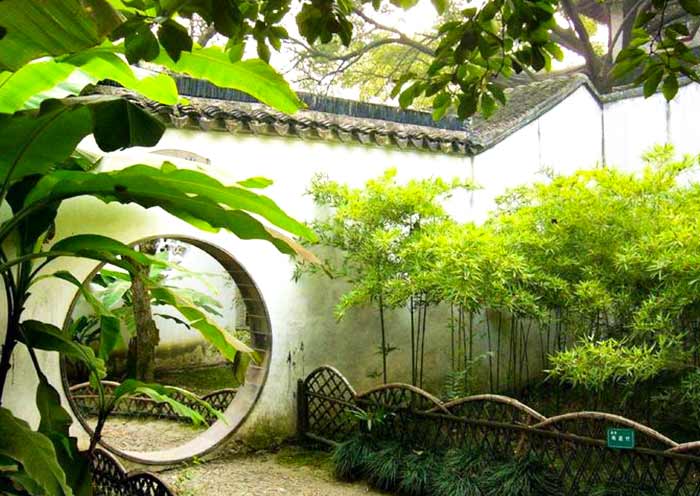
Suzhou Gardens History
Suzhou gardens are an art of time and an art of history. As early as before 2500 BC during the Spring and Autumn period, King Helu of Wu utilized the natural landscape around the suburbs of Suzhou to build Gu Su Mountain. Grand in scale and magnificently built, Gu Su Mountain was the earliest royal garden in Suzhoua.
It is evident that the paradigm of combining architecture with natural landscapes has already had a tradition of over 2000 years. During the Sui and Tang dynasties, Suzhou made further developments in garden construction. Places like Tiger Hill, Lingyan Mountain, Shih Lake, and the eastern and western sides of Dongting Mountain had all become scenic tourist attractions. In the Song dynasty, the trend of building gardens in Suzhou reached its peak. Song literati who built gardens in Suzhou included Su Shunqin’s Canglang Pavilion, Shi Zhenzhi’s Wanjuan Hall (precursor to the Master of the Nets Garden), Jiang Xilu’s Hidden Garden, and Zhu Changwen’s Yule Garden. Among these, the most famous was the poet Su Shunqin’s Canglang Pavilion.
Suzhou became a gathering place for private gardens, with many emerging that belonged to officials and literati families. These gardens were characterized by waterscapes, bamboo, willows, lotus and other sceneries that embodied the Jiangnan style. Some made use of locally quarried Taihu rocks, and gradually garden aesthetics shifted towards an emphasis on rockeries and stacked mountains. The artistic techniques and layout principles became increasingly diverse. The Master of the Nets Garden, considered a masterpiece of Suzhou garden design, also originated at this time. Relying on the naturally beautiful landscapes, the various styles of gardens attained more charm and variation.
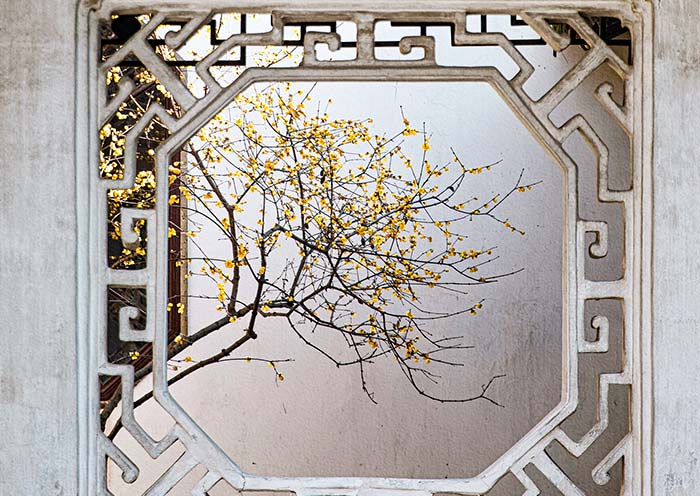
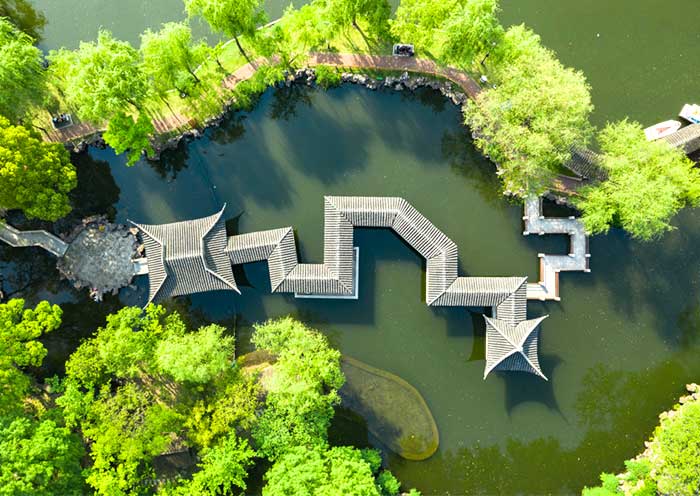
Suzhou Gardens Art & Design
Suzhou's garden designers employed unique techniques to create within limited spaces, through rockeries, waterscapes, floral plantings, and garden architecture, and by incorporating large numbers of horizontal inscribed boards, couplets, paintings, carvings, steles, furniture, ornaments and various decorative pieces, reflections of ancient philosophy, cultural consciousness and aesthetic interest. This resulted in literati-styled landscape gardens full of poetic charm and imagery, that enabled people to "gain the delight of mountains and waters without leaving the city walls, and attain the interest of woods and springs while residing in the bustling marketplace", achieving an artistic realm of "though made by humans, appears as if opened up by nature."
Suzhou's classical gardens are culturally-profound "literati landscape gardens". Their architectural layout, structures, shapes and styles cleverly utilized various garden design techniques and methods involving contrasts, foils, borrowened scenery, shifts in scale and hierarchy, combinations of small to represent the grand, and bringing out more from less. Bringing together pavilions, towers, halls, kiosks, springs, rocks, flowers and trees, they created within the urban setting a harmonious living environment between humans and nature. This constitutes the overall defining characteristics of Suzhou's classical gardens.
The gardens' buildings, structures, forms and styles all ingeniously applied techniques such as contrasts, backdrops, borrowed scenery, shifts in scale and layers, and the use of small to convey large, and less to convey more. By combining pavilions, towers, halls, kiosks, springs, rocks, flowers and trees, they created within the urban setting a harmonious living environment between humans and nature. This forms the overall distinctive features of Suzhou's classical gardens.
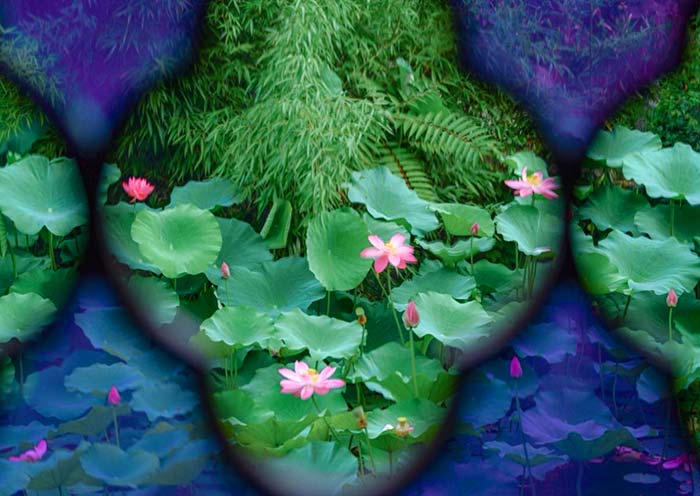
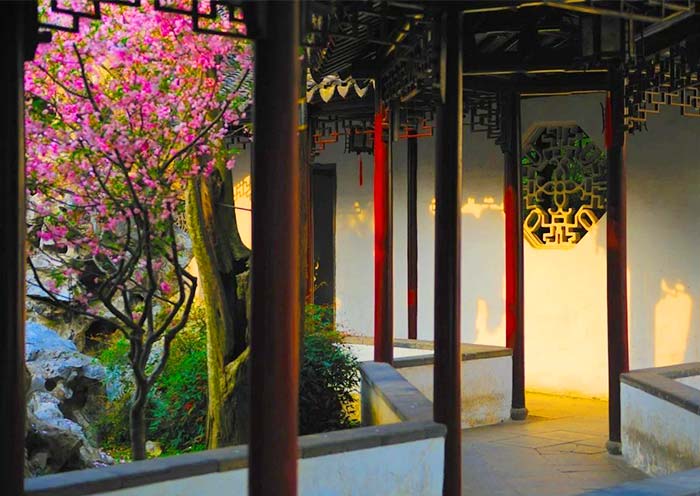
How to Plan Shanghai Suzhou Tours/Trips
It is recommended to allocate 1-2 days in Suzhou, allowing yourself ample time to unravel the enchanting treasures that this city beholds.
Suzhou Day Trip from Shanghai by High Speed Train
Take a Suzhou day trip from Shanghai by high-speed train and immerse yourself in the captivating wonders of the Humble Administrator's Garden, Suzhou Museum, Tiger Hill, stroll along the enchanting Shantang Street, and indulge in a scenic cruise along the Suzhou Grand Canal. View full itinerary of Suzhou Day Trip from Shanghai by High Speed Train >>
Suzhou Day Trip with Classical Gardens & Water Towns
Experience the charm of Suzhou on a captivating day trip that combines visits to the exquisite Humble Administrator's Garden and Suzhou Museum with a delightful exploration of either the picturesque Zhouzhuang Water Town or the enchanting Tongli Water Town. View full itinerary of 1 Day Suzhou Garden & Tongli Water Town Tour from Shanghai >>
2 Days In-depth Suzhou Tour with Classical Gardens & Water Towns
Indulge in an immersive journey through the heart of Suzhou's downtown, where you can embark on an enchanting exploration of iconic attractions such as the Humble Administrator's Garden, Suzhou Museum, Lion Grove Garden, Tiger Hill, and Shantang Street. Delight in a night cultural experience at the mesmerizing Masters of the Nets’ Garden.
Afterward, venture into the neighboring realm of water towns, be it the picturesque splendor of Zhouzhuang or the alluring charm of Tongli, to unravel another day of captivating discoveries. View full itinerary of 2 Days Ultimate Suzhou Garden Tour with Zhouzhuang Water Town >>
For more inspirations, check 10 Best Suzhou Tour Packages >>
Extend Shanghai Suzhou Tours to Other Destinations
"Paradise in Heaven; Suzhou & Hangzhou on Earth." It is a good idea to cover romantic Hangzhou in your trip or extend to Huangshan Yellow Mountain for a nature escape and Hui-style culture. You can also add destinations like Shanghai, Beijing, Xi'an, the Yangtze River, Tibet, the Silk Road, Guilin, Chengdu, Zhangjiajie, and more! Each tour can be fully customized to match your unique interests and preferences, all at the best possible local prices.

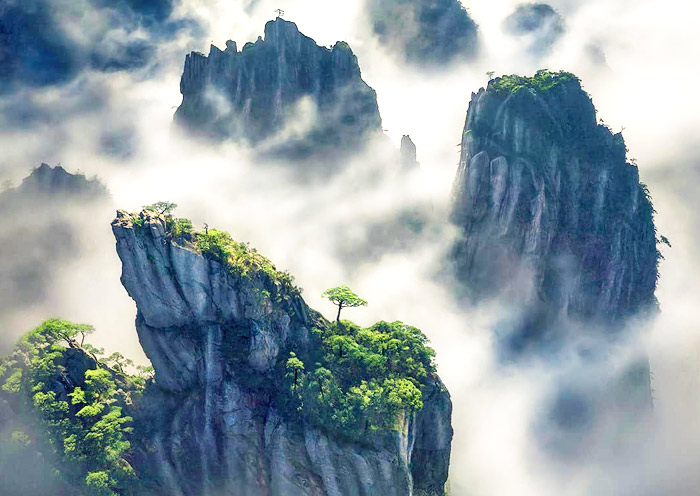
Explore the Yangtze River Delta with Asia Odyssey Travel (AOT)
Embark on a captivating journey through the heart of China's economic and cultural powerhouse with Asia Odyssey Travel (AOT). The Yangtze River Delta offers a compelling blend of rapid modernization and rich cultural heritage, and AOT is your perfect partner to tailor a tour that reflects your unique travel interests.
Useful Yangtze River Delta Travel Guide:
Hangzhou: West Lake, Things to Do in Hangzhou
Suzhou: Things to Do in Suzhou, Suzhou Gardens
Shanghai: The Bund, Yu Garden, Shanghai Itineraries, Things to Do in Shanghai,
Best Time to Visit Shanghai, How to Plan a Shanghai Tour
Yangtze Delta:
China Water Town, How to Plan a Shanghai Hangzhou Suzhou Tour
Tour Packeges: Shanghai Tour, Hangzhou Tour, Suzhou Tour, Huangshan Tours
Contact us today to start planning your adventure, and let us show you the dynamic beauty and enduring traditions of this extraordinary region.
